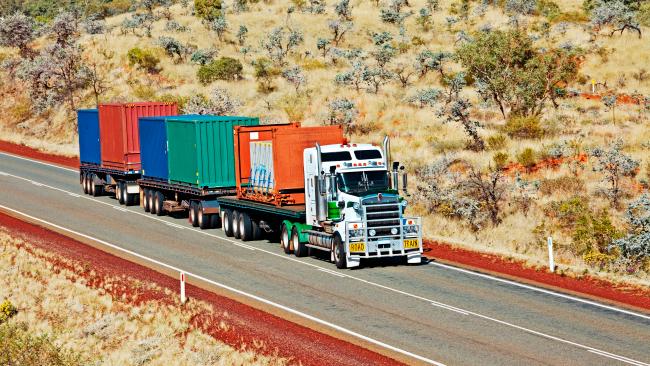Trucks can be intimidating, especially if you’re not used to them. And let’s face it, most of us are more likely to cross paths with a Barina than a big rig.
If you’re based in any of the capital cities, you’ll know that they get bigger the further north and west you go. Rigid urban delivery trucks will make way for semi-trailers and B-doubles as you get into regional and rural areas. Venture further afield and you’ll eventually run into road trains.
These can be up to 53.5 metres, according to the government’s National Heavy Vehicle Regulator. If you’re used to zipping in and out of traffic on metropolitan freeways, the idea of overtaking one of these behemoths – with their multiple trailers – can be a little scary.
Or worse, being overtaken.

First step to truck club? Don’t panic when you see one in the mirror. Picture: Getty Images
Unwritten etiquette about trucks
Any road-trip enthusiast will have been there. Cruising along the highway into the evening, when you notice the two little spots that have been sitting on the horizon behind you are suddenly looming large. You’ll check your rear-view mirror and all you’ll be able to see is the two huge unblinking eyes of the headlights staring straight back into your retinas.
I was discussing this recently with a truckie called Trev at a roadhouse along the Newell Highway from Victoria to Southern Queensland. It’s a busy transport corridor, with long-haul trucks of all shapes and sizes, and he told me there’s an unwritten rule of road etiquette I didn’t know.
I put it to the test – multiple times – and found that not only did it work seamlessly, but it made me feel safer while creating a sense of camaraderie with every truck I encountered. It starts with one of the fundamental principles we all learn with our L-plates on: clear communication.
This is essential to road safety. That’s why cars come with safety equipment like indicators, brake lights, reverse lights, and hazard lights. Making your intentions clear to other road users allows them to anticipate your movement and adjust accordingly, keeping everyone safe and happy.
With that in mind, here are Trev’s steps to changing the way you interact with trucks forever.

Road trains can be up to 53.5 metres in length, so they’re not exactly agile. Picture: Getty Images
Four simple steps to help trucks overtake
Step 1: The truck is sitting right behind you. You’re both travelling at the speed limit. You want it to pass. What do you do? If the road ahead is clear and it’s safe to do so, you can communicate to the driver that you will help them pass by flashing your right indicator. The truck has a higher point of view, so the driver will look ahead and confirm it’s safe.
Step 2: Now that the driver knows you’re going to help them, they may indicate and move across to start overtaking you. If that happens, the best thing you can do at this point is slow down, because this will help them complete the manoeuvre as quickly and safely as possible. It doesn’t mean decelerating to a crawl, just lifting your foot off the pedal for a couple of seconds, which will give them the advantage they need to power past.
Step 3: Once the back trailer has cleared your bonnet (and remember, there may be multiple trailers behind the prime mover), you can briefly flash your high-beam lights. This will tell the driver it’s safe to move back across to the left lane in front of your car. Again, this is a simple communication strategy that helps the truck driver know when it’s safe to move.
Step 4: Now that the truck is safely in front of you and pulling away, it’s likely that the truck driver will communicate back to say thank you. Generally, they will alternate flashes of their left and right indicators to let you know that they appreciate your help.

Communication is key, just like every workplace in Australia. Picture: Getty Images
Remember truckies are professional drivers
Sharing the road with trucks doesn’t have to be scary. One of the main things to understand is that they have large blind spots and need more room to stop and turn than cars.
“Our roads and highways are a truck driver’s workplace, so it’s really important we are aware and respectful of their needs, especially when it comes to sharing the road safely,” Emily Mills, spokesperson for the Australian Trucking Association (ATA), tells Escape.
“Avoiding truck blind spots, not cutting in front, and giving them plenty of space when they’re turning makes such a big difference. Truck drivers are professionally trained – everything they do on the road is planned to keep themselves, road users and their load safe.”
Another simple thing that will help you stay safe while driving around trucks is to keep rest areas clear. Fatigue has a huge impact on road safety. A study from the Adelaide Centre for Sleep Research found that a person who has been awake for 17 hours has the same risk of crashing as someone with a blood alcohol content reading of 0.05 (the legal limit). A person who has been awake 24 hours, meanwhile, is seven times more likely to have an accident.
Most road-trippers and caravanners have considered pulling up in designated truck bays at one point or another. The ease! The space! The need to get out of the car before your kids kill each other in the back seat! However, pulling up a bit further down the road, or in the car parking area, ensures truckies can rest which helps keep us all safe on our highways.
To give car drivers an understanding of things from a truck driver’s perspective, the ATA created Safet360 – a virtual reality experience accessible anywhere, anytime. Before you hit the road, put yourself in the virtual driver’s seat at www.safet360.com.au.


